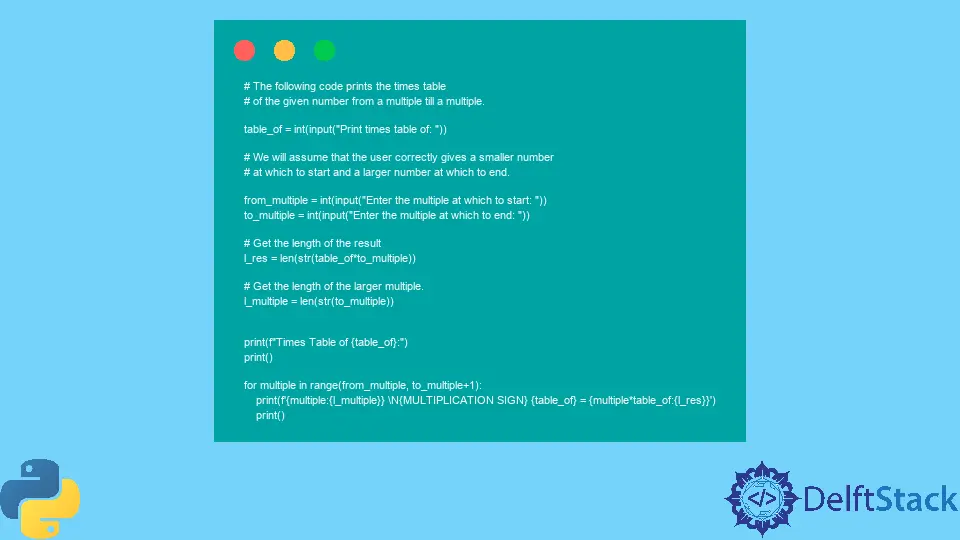Imprima una tabla de multiplicar en Python usando conceptos básicos de programación

Podemos practicar varios conceptos elementales de programación aprendiendo a imprimir una tabla de multiplicar en Python. Éstos incluyen:
- Usando variables
- Obtener información del usuario
- Uso de funciones integradas
- Escriba las variables de conversión
- Iteración (bucle)
- Formato de cadena
- Usar un símbolo Unicode
Usaremos la función de formato de cadena f de Python, disponible para Python 3.6 y superior.
Conceptos básicos de programación
Podemos declarar una variable y asignarle un valor de la siguiente manera.
table_of = 5
Usaremos la función input() para obtener la entrada del usuario, como se muestra a continuación.
table_of = input("Print times table of: ")
El programa mostrará la cadena Imprimir tabla de tiempos de: y esperará la entrada del usuario. El usuario puede ingresar cualquier cosa. Python interpreta la entrada como una cadena.
Para convertirlo a un número entero, usaremos la función int() alrededor de la función input().
table_of = int(input("Print times table of: "))
print("Times") imprime la palabra Times en la pantalla. Una función print() vacía imprime una línea vacía.
La función range() crea una secuencia desde start_int hasta, pero excluyendo, end_int. Por defecto, aumenta en 1.
range(start_int, end_int, step_int)
Usaremos el bucle for en nuestro código. Repite el código en el bucle tantas veces como la variable esté en el rango especificado.
for variable in range(start, end):
code to repeat
La función de formato de cadena f de Python nos permite incluir variables en cadenas usando marcadores de posición {}. Para utilizar el valor de la variable table_of, utilizaremos:
print(f"Times table of {table_of}")
Podemos especificar la longitud del marcador de posición utilizando un número entero. En el código, especificamos esto usando otra variable: la longitud del resultado table_of * 9.
Convertimos el número entero en una cadena usando str() para obtener la longitud.
El símbolo de multiplicación se especifica utilizando su nombre Unicode.
\N{MULTIPLICATION SIGN}
Imprimir la tabla de multiplicar de un número dado en Python
Ahora pondremos todos los conceptos anteriores en el siguiente código. Imprimirá la tabla de multiplicar del número dado por el usuario de dos maneras.
Código de ejemplo:
# The following code prints the times table
# of the given number till 'number x 9'.
# It prints the times table in two different ways.
table_of = int(input("Print times table of: "))
# Get the length of the result
l_res = len(str(table_of * 9))
print(f"Times Table of {table_of}:")
print()
for multiple in range(1, 10):
print(
f"{multiple} \N{MULTIPLICATION SIGN} {table_of} = {table_of*multiple:{l_res}}"
)
print()
print("-------------")
print()
for multiple in range(1, 10):
print(
f"{table_of} \N{MULTIPLICATION SIGN} {multiple} = {table_of*multiple:{l_res}}"
)
print()
Salida de muestra:
Print times table of: 1717
Times Table of 1717:
1 × 1717 = 1717
2 × 1717 = 3434
3 × 1717 = 5151
4 × 1717 = 6868
5 × 1717 = 8585
6 × 1717 = 10302
7 × 1717 = 12019
8 × 1717 = 13736
9 × 1717 = 15453
-------------
1717 × 1 = 1717
1717 × 2 = 3434
1717 × 3 = 5151
1717 × 4 = 6868
1717 × 5 = 8585
1717 × 6 = 10302
1717 × 7 = 12019
1717 × 8 = 13736
1717 × 9 = 15453
Como variación, podemos imprimir la tabla de multiplicar desde y hasta un múltiplo deseado del número dado.
Código de ejemplo:
# The following code prints the times table
# of the given number from a multiple till a multiple.
table_of = int(input("Print times table of: "))
# We will assume that the user correctly gives a smaller number
# at which to start and a larger number at which to end.
from_multiple = int(input("Enter the multiple at which to start: "))
to_multiple = int(input("Enter the multiple at which to end: "))
# Get the length of the result
l_res = len(str(table_of * to_multiple))
# Get the length of the larger multiple.
l_multiple = len(str(to_multiple))
print(f"Times Table of {table_of}:")
print()
for multiple in range(from_multiple, to_multiple + 1):
print(
f"{multiple:{l_multiple}} \N{MULTIPLICATION SIGN} {table_of} = {multiple*table_of:{l_res}}"
)
print()
Salida de muestra:
Print times table of: 16
Enter the multiple at which to start: 5
Enter the multiple at which to end: 15
Times Table of 16:
5 × 16 = 80
6 × 16 = 96
7 × 16 = 112
8 × 16 = 128
9 × 16 = 144
10 × 16 = 160
11 × 16 = 176
12 × 16 = 192
13 × 16 = 208
14 × 16 = 224
15 × 16 = 240
